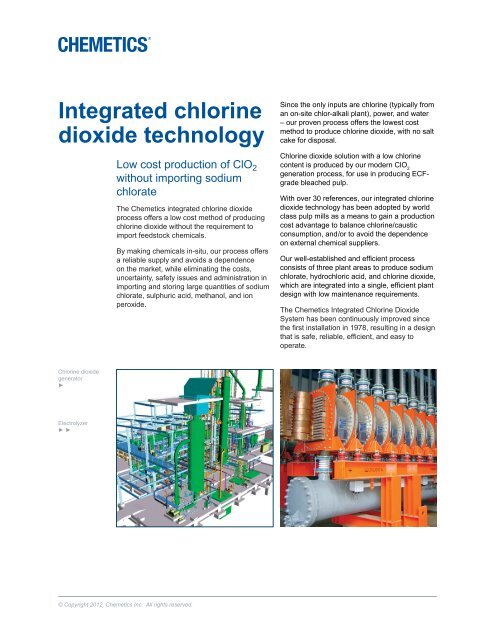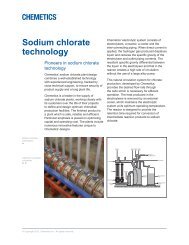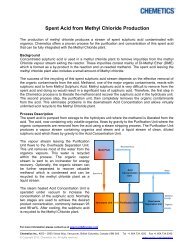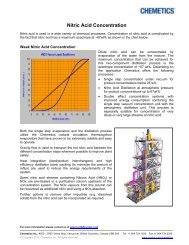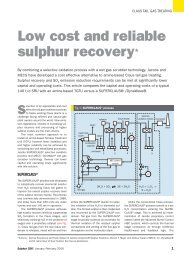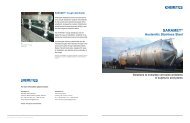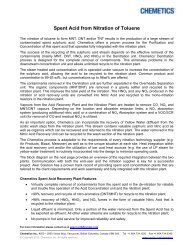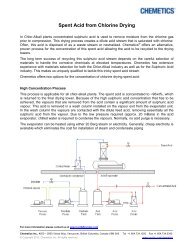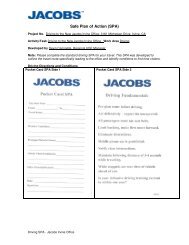Integrated chlorine dioxide technology
Integrated chlorine dioxide technology
Integrated chlorine dioxide technology
Create successful ePaper yourself
Turn your PDF publications into a flip-book with our unique Google optimized e-Paper software.
<strong>Integrated</strong> <strong>chlorine</strong><br />
<strong>dioxide</strong> <strong>technology</strong><br />
Chlorine <strong>dioxide</strong><br />
generator<br />
►<br />
Electrolyzer<br />
► ►<br />
Low cost production of ClO 2<br />
without importing sodium<br />
chlorate<br />
The Chemetics integrated <strong>chlorine</strong> <strong>dioxide</strong><br />
process offers a low cost method of producing<br />
<strong>chlorine</strong> <strong>dioxide</strong> without the requirement to<br />
import feedstock chemicals.<br />
By making chemicals in-situ, our process offers<br />
a reliable supply and avoids a dependence<br />
on the market, while eliminating the costs,<br />
uncertainty, safety issues and administration in<br />
importing and storing large quantities of sodium<br />
chlorate, sulphuric acid, methanol, and ion<br />
peroxide.<br />
© Copyright 2012, Chemetics Inc. All rights reserved.<br />
Since the only inputs are <strong>chlorine</strong> (typically from<br />
an on-site chlor-alkali plant), power, and water<br />
– our proven process offers the lowest cost<br />
method to produce <strong>chlorine</strong> <strong>dioxide</strong>, with no salt<br />
cake for disposal.<br />
Chlorine <strong>dioxide</strong> solution with a low <strong>chlorine</strong><br />
content is produced by our modern ClO 2<br />
generation process, for use in producing ECFgrade<br />
bleached pulp.<br />
With over 30 references, our integrated <strong>chlorine</strong><br />
<strong>dioxide</strong> <strong>technology</strong> has been adopted by world<br />
class pulp mills as a means to gain a production<br />
cost advantage to balance <strong>chlorine</strong>/caustic<br />
consumption, and/or to avoid the dependence<br />
on external chemical suppliers.<br />
Our well-established and efficient process<br />
consists of three plant areas to produce sodium<br />
chlorate, hydrochloric acid, and <strong>chlorine</strong> <strong>dioxide</strong>,<br />
which are integrated into a single, efficient plant<br />
design with low maintenance requirements.<br />
The Chemetics <strong>Integrated</strong> Chlorine Dioxide<br />
System has been continuously improved since<br />
the first installation in 1978, resulting in a design<br />
that is safe, reliable, efficient, and easy to<br />
operate.
Chemetics’ proven,<br />
low-operating cost<br />
process for the<br />
production of <strong>chlorine</strong><br />
<strong>dioxide</strong> without<br />
sodium chlorate<br />
import. Inputs to<br />
the process are just<br />
water, <strong>chlorine</strong>, and<br />
electricity.<br />
►<br />
Overall process integration<br />
As illustrated, the Chemetics <strong>Integrated</strong> Chlorine<br />
Dioxide System consists of three plant areas to<br />
produce the two intermediate products, sodium<br />
chlorate (NaClO 3 ) and hydrochloric acid (HCl),<br />
and the final product, <strong>chlorine</strong> <strong>dioxide</strong> (ClO 2 ).<br />
Sodium chlorate is produced by passing an<br />
electric current through a solution that contains<br />
sodium chloride (salt) to make strong sodium<br />
chlorate liquor. The salt for this reaction is a<br />
recycled by-product from the <strong>chlorine</strong> <strong>dioxide</strong><br />
production area. Hydrogen gas is co-produced<br />
with the sodium chlorate, and is used as a<br />
feedstock for hydrochloric acid production.<br />
Hydrochloric acid is produced by burning<br />
<strong>chlorine</strong> gas and hydrogen gas. The hydrogen<br />
gas comes from the sodium chlorate electrolysis<br />
Chlorine<br />
(purchased, or from<br />
on-site chloralkali plant)<br />
Electric<br />
Power<br />
Sodium<br />
Chlorate<br />
Production<br />
hydrogen<br />
sodium<br />
chlorate<br />
weak chlorate liquor<br />
Performance Data<br />
ClO Solution Specification<br />
2<br />
ClO : 8 – 10 g/L<br />
2<br />
Cl : 0.2 g/L<br />
2<br />
HCl: 0.5 – 1.0 g/L<br />
Consumption per tonne of ClO2 Raw Materials: Chlorine 0.7 tonne<br />
Power: Power 8,500 – 9,500 kWh D.C.<br />
© Copyright 2012, Chemetics Inc. All rights reserved.<br />
HCl<br />
Production<br />
Cl2<br />
HCl<br />
Chlorine<br />
Dioxide<br />
Production<br />
water<br />
water<br />
Chlorine<br />
Dioxide<br />
Solution<br />
area. Make-up <strong>chlorine</strong> gas comes from the<br />
plant battery limits. Weak <strong>chlorine</strong> gas, a<br />
recycled by-product of the <strong>chlorine</strong> <strong>dioxide</strong><br />
generation area, is combined with this <strong>chlorine</strong><br />
make-up stream prior to being burned with the<br />
hydrogen gas.<br />
Chlorine <strong>dioxide</strong> gas is produced, along<br />
with <strong>chlorine</strong> gas and sodium chloride (salt),<br />
by combining strong chlorate liquor and<br />
hydrochloric acid in the <strong>chlorine</strong> <strong>dioxide</strong><br />
generator. The <strong>chlorine</strong> <strong>dioxide</strong> gas is absorbed<br />
in chilled water and then stripped with air to<br />
remove residual <strong>chlorine</strong>, to produce a highpurity<br />
<strong>chlorine</strong> <strong>dioxide</strong> solution for use in the<br />
ECF pulp mill bleach plant.<br />
The liquor leaving the generator contains<br />
unreacted sodium chlorate and the by-product<br />
salt. This solution, called weak chlorate liquor, is<br />
recycled back to the sodium chlorate electrolysis<br />
area for reconcentration. The <strong>chlorine</strong> byproduct<br />
(weak <strong>chlorine</strong>), which is not absorbed,<br />
is recycled for hydrochloric acid production.<br />
As a result of the integration of these three<br />
plant areas, the key operating costs are for<br />
make-up <strong>chlorine</strong>, and for electrical energy that<br />
is consumed in sodium chlorate electrolysis<br />
area. With these relatively low-cost inputs,<br />
the integrated <strong>chlorine</strong> <strong>dioxide</strong> process offers<br />
much lower production costs than competing<br />
processes that require the purchase of sodium<br />
chlorate, acids, methanol, and/or hydrogen<br />
peroxide.<br />
Features:<br />
■ Lowest production cost<br />
■ High purity (low <strong>chlorine</strong> product)<br />
■ No purchased chlorate, acid, methanol, or<br />
peroxide is required<br />
■ Security of supply for feedstocks<br />
■ Improves the balance of pulp mill <strong>chlorine</strong>/<br />
caustic consumption<br />
■ No solids handling<br />
■ No salt cake for disposal<br />
Chemetics Inc. Phone: +1 604 734 1200<br />
Suite 200 – 2930 Virtual Way Fax: +1 604 734 0340<br />
Vancouver, British Columbia, Canada V5M 0A5 Email: chemetics.info@jacobs.com www.jacobs.com/chemetics


